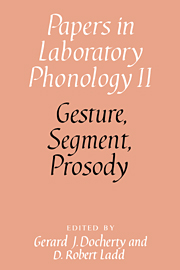Book contents
- Frontmatter
- Contents
- List of contributors
- Acknowledgments
- Introduction
- Section A Gesture
- 1 An introduction to task dynamics
- 2 “Targetless” schwa: an articulatory analysis
- 3 Prosodic structure and tempo in a sonority model of articulatory dynamics
- 4 Lenition of |h| and glottal stop
- 5 On types of coarticulation
- Section B Segment
- Section C Prosody
- Appendix 1 The test phrases (bold type) of experiment 1 in the context in which they were read
- Appendix 2 The distractors (bold type) of experiment 1 in the context in which they were read
- Appendix 3 The test sentences of experiment 2. The test words are in bold type
- Appendix 4 The distractor sentences of experiment 2. The distractors are in bold type
- References
- Name index
- Subject index
4 - Lenition of |h| and glottal stop
from Section A - Gesture
Published online by Cambridge University Press: 18 December 2009
- Frontmatter
- Contents
- List of contributors
- Acknowledgments
- Introduction
- Section A Gesture
- 1 An introduction to task dynamics
- 2 “Targetless” schwa: an articulatory analysis
- 3 Prosodic structure and tempo in a sonority model of articulatory dynamics
- 4 Lenition of |h| and glottal stop
- 5 On types of coarticulation
- Section B Segment
- Section C Prosody
- Appendix 1 The test phrases (bold type) of experiment 1 in the context in which they were read
- Appendix 2 The distractors (bold type) of experiment 1 in the context in which they were read
- Appendix 3 The test sentences of experiment 2. The test words are in bold type
- Appendix 4 The distractor sentences of experiment 2. The distractors are in bold type
- References
- Name index
- Subject index
Summary
Introduction
In this paper we examine the effect of prosodic structure on how segments are pronounced. The segments selected for study are /h/ and glottal stop /?/. These segments permit us to concentrate on allophony in source characteristics. Although variation in oral gestures may be more studied, source variation is an extremely pervasive aspect of obstruent allophony. As is well known, /t/ is aspirated syllable-initially, glottalized when syllable-final and unreleased, and voiced throughout when flapped in an intervocalic falling stress position; the other unvoiced stops also have aspirated and glottalized variants. The weak voiced fricatives range phonetically from essentially sonorant approximants to voiceless stops. The strong voiced fricatives exhibit extensive variation in voicing, becoming completely devoiced at the end of an intonation phrase. Studying /h/ and /?/ provides an opportunity to investigate the structure of such source variation without the phonetic complications related to presence of an oral closure or constriction. We hope that techniques will be developed for studying source variation in the presence of such complications, so that in time a fully general picture emerges.
Extensive studies of intonation have shown that phonetic realization rules for the tones making up the intonation pattern (that is, rules which model what we do as we pronounce the tones) refer to many different levels of prosodic structure.
- Type
- Chapter
- Information
- Gesture, Segment, Prosody , pp. 90 - 127Publisher: Cambridge University PressPrint publication year: 1992
- 57
- Cited by

